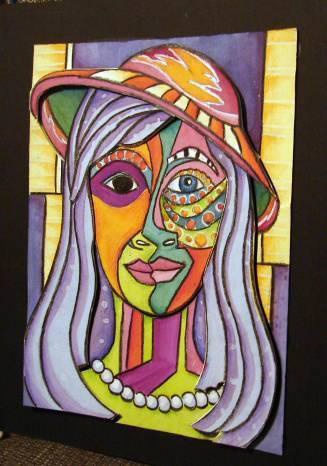Target Group:
Grades 6-8
Goal (Terminal Objective):
Students will create a portrait in relief with inspiration taken from the portraits of Pablo Picasso.
Objective:
Students will become familiar with the work and the artistic philosophy of Pablo Picasso. Students will create a portrait inspired by the work of Picasso – including more than one viewpoint of the person in the design. The Elements and Principles of Art Line, Shape, Color, Value, Space, Form, Emphasis, Proportion, Movement, Variety, and Repetition will be used in this work of art.
National Standards:
Visual Arts Grades 58 Content Standard 1: Understanding and applying media, techniques, and processes
Visual Arts Grades 58 Content Standard 2: Using knowledge of structures and functions
Visual Arts Grades 58 Content Standard 3: Choosing and evaluating a range of subject matter, symbols, and ideas
Visual Arts Grades 58 Content Standard 4: Understanding the visual arts in relation to history and other cultures
Visual Arts Grades 58 Content Standard 5: Reflecting upon and assessing the characteristics and merits of their work and the work of others
Purpose:
Students will reinforce good design skills and their knowledge of the Elements and Principles of Art in creating this work of art. The students will become aware of how an artist’s style develops from influences in the artist’s environment and the world around him/her.
Students will also become aware of the ability to be able to combine more than one viewpoint in the same work of art and how creating different levels in their relief will create interests and shadows that will compliment the work.
New Vocabulary:
Cubism, relief, shims, wax or crayon resist, transparent, Abstract, styles of art, series, palette
Materials:
tag board or Bristol board; black mat board; and/orxacto knives
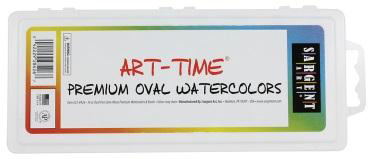
#22-8426 Semi-Moist Oval Watercolor Set
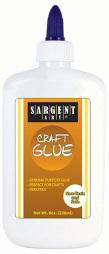
#22-1103 White Glue
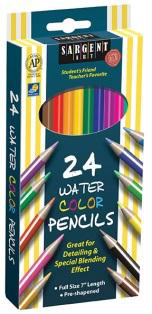
#22-7205 Watercolor Pencils
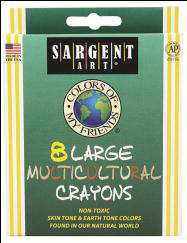
#35-0581 Large Skin Tone Crayons

#22-7244 144 ct. Graphite Pencils

#23-5026 25 sheet Watercolor Pad

#22-0914 12 ct. Pointed Tip Student Scissors Best-Pack
Time:
5-7 class periods
Introduction and Motivation (Set):
Introduce students to the life and work of Pablo Picasso. Look at the way his style changed from realism to abstraction. Discuss why Picasso was interested in starting a new artistic movement in Cubism.
Discuss why he wanted to paint “like a child” and how he included more than one view of his subject in his work.
Show examples of Picasso’s work and discuss how he used the Elements and Principles of Art in his work – particularly Line, Color, Value, Shape, Space, Emphasis, Proportion, Repetition, Variety, and Movement.
Show students the finished example of this assignment and have them compare it to the portraits of Pablo Picasso.

Instruction:
Students will make thumbnail sketches of their ideas for their Picasso portrait designs. They will need to have at least three different designs. They will choose their best design for the assignment with the help of the teacher.
Students will enlarge their design so that it will fit on their 9”x12” sheet of a stiff white paper
(80 lb white sulphite paper, watercolor paper, Bristol board, or white tag board).

Students will then go over the lines in their drawings with a black crayon from their Sargent Art Large Skin Tone Crayons. The point of the crayon will stay sharp if the crayon is rotated frequently as the student is using it. The crayon will need to be applied heavily so that it will provide a barrier for the watercolor so that it will not run from one shape to another. This technique is known as crayon or wax resist.
Demonstrate how to use and care for watercolors using the Sargent 16 Oval Semi Moist Watercolor Set. Emphasize that watercolor is a transparent medium and several light layers can be placed one over another to create shading and blending of one color into another. White crayon can be added to the design to create an interesting pattern or texture before the paint is added.

The colors will be much more interesting if students mix their own colors using a palette such as the Sargent 8 Well Palette with Brush Recess, rather than using the colors straight from the box of watercolors. The lid of the watercolor box may be used as a palette as well.
After the paintings have dried, students can add shading to their paintings with Sargent Art 24 Count Watercolor Pencils. Demonstrate how to use these pencils. Students will need to keep the points sharp and can gradate the shading from dark to light. Students can activate the colors with water or not.

To create a relief, students will need to cut their painting into parts. Before they begin cutting, they will need to decide which parts of their painting will be higher or lower than the others. (There are four different levels in the example.)
Mat board, at least 11”x14”, will be used for the base of the relief. The painting should be reassembled on the mat board in such a manner that there is an even border around the picture.
Shims or small squares of mat board or cardboard should be cut to be used to raise the different levels of the relief. The lowest levels should have no shims and will be glued directly onto the

black mat board. The next highest level will have one layer of shims glued around the outside edges on the back side of the cut shapes.
As the layers need to be higher, an extra layer of shims will be added to the tops of the shims already glued along the edges of the shapes. The highest layer in the example has 4 shims glued on top of each other all around the edge of the shapes.
When the glue has dried, the shapes can be placed back together to create the finished design. They may look best if some shapes are slightly overlapping, and some may look good if they are slightly pulled apart so that the black of the mat board is showing through. Now glue.
The pieces will need to be weighted down as they are drying so that the pieces will not curl up, and all parts of the shapes will be affixed to the base.


Students will critique their work, comparing their work to that of Picasso’s portraits. They will give their work a title, and rate themselves on the criteria for the assignment creativity and craftsmanship. They will point out how they used Line, Shape, Color, Value, Form, Emphasis, Movement, Proportion, Variety, and Repetition.
Activities:
(1) Guided Practice:
- Create thumbnail sketches of their portrait.
- Choose the best design with help of the teacher.
- Enlarge the design to fill 9”x12” watercolor paper or other paper of teacher’s choice.
- Go over lines with black crayon, keeping the crayonheavy
- Go over lines with black crayon, keeping the crayon heavy.
- Watch watercolor demonstration
- Add white crayon to design for variety or pattern.
- Add watercolor to the design, keeping the watercolor transparent and mixing colors to keep a variety of colors.
- Add shading to the work with watercolor pencils, keeping the points sharp to maximize the quality of shading.
- With the help of the teacher, students will decide how to cut apart their paintingto create different levels for their relief.
- Cut apart different shapes with scissors or xacto knife. If xactoknife is used, emphasize safety concerns while using the knives.
- Watch demonstration on how to add shims to the back of shapes.
- Add shims. Have at least four different heights for the shapes.
- Let glue Arrange the pieces on the black mat board and affix them to it with glue placing something heavy or holding down the individual pieces until they dry so that they will dry flat and not curlup.
(2) Independent Practice and Check for Understanding:
The teacher will circulate among the students as they work to make sure that they are using the materials correctly and to be sure that they understand the concepts of the design. The teacher will ask direct questions when understanding isnot observed and will redirect students in a kind and reassuringmanner.Students will be encouraged and directed using positive reinforcement.
(3) Closure:
Students will complete a critique on their work.They will give their work a title, compare it to the portraits of Picasso, and rate themselves on criteria creativity and craftsmanship. They will discuss how they used Line, Shape, Color, Value, Form, Proportion, Emphasis, Variety, Movement, andRepetition.
Evaluation:
Level One – The finished work will be a creative portrait in relief inspired by the work of Pablo Picasso. The student will have included a side view as well as a frontal view of the person in their design. The student should have a variety of lines, values, colors, and shapes in their work. There should be at least four levels in the relief put together in a pleasing manner. Creativity, following the criteria for the assignment, and craftsmanship should be excellent.
Level Two – The finished work will be a creative portrait in relief inspired by the work of Pablo Picasso. The student will have included a side view, as well as a frontal view of the person in their design. The student should have a variety of lines, values, colors, and shapes in their work. There should be at least four levels in the relief put together in a pleasing manner. Creativity, following the criteria for the assignment, and craftsmanship should be good.
Level Three – The finished work will be a portrait in relief. It may or may not be in the style of the portraits by Pablo Picasso having more than one view of the person. Variety and proportion is definitely lacking in this work. Creativity is lacking, criteria for the assignment has not been followed, and craftsmanship is poor.
Level Four – The finished portrait may or may not be in relief. The style of Pablo Picasso has not been attempted by the student. Creativity and craftsmanship is unsatisfactory.
Extension:
Students could set up a still life from objects in the room, their backpacks, purses or pockets. They could make a drawing of the still life in the style of Pablo Picasso as they did for the portrait. They can add color with watercolor, watercolor pencils, lines with black crayon, and patterns and textures with the white crayons. Shading could be done with the watercolor pencils. The illusion of space can be added by creating a relief by cutting the painting into pieces and raising those pieces with shims added to the back ofthe shapes.
Resources:
http://www.picasso.com/index.html
http://sansite.unc.edu/cjackson/picasso/picasso22.jpg
http://cgfa.dotsrc.org/picasso5.jpg
http://images.search.yahoo.com/search/images?_adv_prop=image&fr=yfpt501 s&va=picasso+paintings&s2=
Art Consultant



